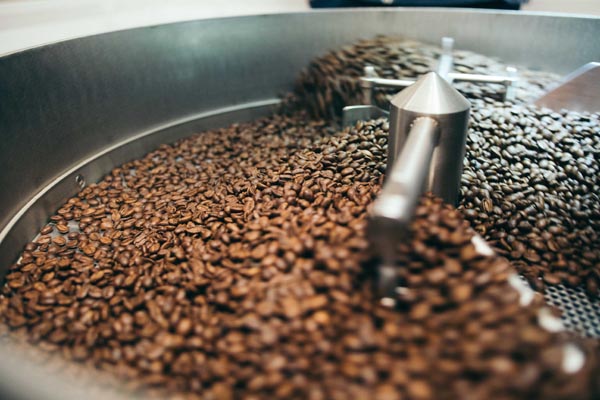An in-depth look at the process and its impact on taste.
Welcome, fellow coffee aficionados! Today, we’re embarking on an exciting journey into the heart of the coffee world, delving deep into the art of roasting. In this comprehensive guide, we’ll explore the intricate process of transforming humble green beans into aromatic and flavourful treasures, ready to be brewed into your morning cup.
We’ll examine the various stages of roasting, the impact of different roast profiles on the flavour and complexity of the final cup, and the delicate balance of science and artistry that defines this age-old craft. So, grab your favourite mug, get comfy, and join us as we unlock the secrets of coffee roasting.
What is Coffee Roasting?
Coffee roasting is the process of heating green coffee beans to a high temperature and then allowing them to develop their distinct characteristics. Coffee roasting is an integral step in producing the beloved cup of joe we know and love. It involves physical and chemical modifications to the beans that significantly influence flavour and aroma.
Basic steps
To guarantee consistent roasting results, it’s essential to properly prepare your beans and use a reliable roaster. Be sure the beans are uniform in size and colour – the more even these characteristics are, the smoother your roast will be.
Once your beans have roasted, it is essential to take them away from the heat and cool them quickly. There are several ways to do this, such as placing them on a cookie sheet or swishing them between two metal colanders. Doing so will allow the beans to cool quickly while also eliminating any chaff (the outer shell that was shed during roasting).
Another option is to spread your beans out on baking paper to protect the plastic coating from melting in the oven. While this method won’t remove as much chaff, it will allow you to keep your beans longer without exposing them to too much heat. Once your beans have cooled, store them in an airtight container until you’re ready to enjoy them. You can also freeze roasted coffee to extend its shelf life. However, keep in mind that freezing will not stop oxidation and thus may lose some of its flavour and aroma.
Quality, freshly roasted coffee is an irresistible treat for anyone. Not only does it start your day off right, but it will give you energy throughout the day as well. Once you understand the fundamentals of coffee roasting, you can experiment with various bean varieties and blends. With each new experience comes an increased appreciation for what makes each coffee unique in terms of body, acidity and aroma. The development stage is the most critical element in roasting your beans. Here, all chemical changes take place and it’s important to consider how long you want your beans to mature; this will determine their unique flavour profile.
Temperature
Roasting coffee beans at higher temperatures for extended periods causes a series of chemical reactions inside the bean that give it its distinctive flavour, aroma and texture. These include compounds produced during the Maillard reaction, Strecker degradation, pyrolysis and other processes – each contributing to unique aromas and tastes.
The roasting process is designed to regulate the development of volatile compounds to achieve desired flavour, aroma and texture. In particular, roasting time and temperature must be adjusted for chemical reactions to take place without burning the beans. The caramelisation of sugars in coffee beans occurs at various temperatures and rates.
The Maillard reaction occurs when melanoidin, or caramel-like compounds, are produced. These melanoidins give roast coffee its caramel-like taste and contribute to the browning of the bean. Their quantity and degree may differ depending on what kind of coffee is being roasted. Other chemical transformations that take place during roasting include the formation of coffee phenols, which impart a rich, sweet and acidic flavour to roasted coffee.
Time
Roasting time is an integral factor in coffee roasting that can significantly influence its flavour. Some beans benefit from longer roasts to maintain sweetness, while others require a shorter roast to retain acidity. Lighter roasts are typically roasted between 350°F-400°F (177°C-204°C) for around 10 minutes, while medium roasts require closer to 15 minutes above 400°F.
As the beans roast, they undergo an endothermic reaction – meaning they absorb energy. As the temperature increases, however, they will switch into an exothermic reaction and release this stored energy; this explains why they will crack and pop during the first few minutes after roasting. They will also expand and release a lot of moisture in the form of steam, giving off an unpleasant odour – like wet hay. As the beans continue to warm, their colours will darken and become marled in appearance due to the Maillard reaction which is beginning to alter the flavour of the bean.
Now is an ideal time to stir your beans, as this will help maintain an even temperature throughout the entire batch and guarantee all beans have received equal exposure to heat. At this stage, the bean’s heat is slowly breaking down its sugars and caramelizing them. This process gives coffee its distinctive nuttiness, chocolaty aroma, and thick and rich body.
Once roasting is complete, beans should be placed on a cooling tray to allow them to cool. As beans tend to lose much of their moisture during this process, it’s critical that you quickly cool them below 40°F or else you may damage their flavour and aroma.
Once cooling has completed, you can brew and enjoy your freshly roasted coffee. For optimal flavour development, give the beans a day or so to cool before tasting them for yourself. When you’re ready to enjoy your coffee, try adding a dash of milk and sugar or honey for an added layer of flavour. This will bring out the best in each sip.
Variations
The roasting process is an intricate series of steps that can significantly affect the flavour of your cup. Moreover, depending on how much coffee is roasted during each stage, different levels of caffeine may be present in each cup.
Air temperature and humidity are two important variables that can influence the roasting process, helping to create a consistent flavour while also preserving the aroma and body of the coffee. Another factor that can influence the roasting process is the origin of the green coffee bean. Some regions may have a preference for certain roasts or even have specific preparation techniques that affect their overall flavour. In addition to air temperature and humidity, green beans’ moisture content plays a significant role in how they will roast. To combat this, he typically uses less heat during wintertime since dry air causes them to lose moisture quickly and roast too quickly.
A reliable storage system is key for keeping freshly roasted coffee fresh and flavourful, preserving its aroma, colour, and caffeine concentration for optimal taste. When stored properly, coffee can retain these aromatics up to weeks or even months after roasting. Therefore, it’s essential to taste and record every batch of coffee you roast so that you can adjust your method according to the results. This should be an ongoing process; over time, this will help you become an even better roaster by honing your machine and improving your technique.
When storing your roasted coffee, one final factor to consider is the type of container. An opaque, airtight container helps preserve the flavour and aroma of roasted coffee for extended storage. Although roasting coffee requires different temperatures, it’s always beneficial to store your green beans in a dark place that is neither too hot nor cold. Doing this helps preserve the roasted flavour so customers can enjoy their coffee at its peak enjoyment.
In conclusion, our exploration into the art of roasting has revealed the intricate dance of heat, time, and skill required to transform raw coffee beans into the perfect cup of bliss. We’ve delved into the science behind the process, unravelled the complexities of roast profiles, and gained a newfound appreciation for the expertise and finesse of master roasters.
As we savour our next brew, let’s take a moment to ponder the myriad of factors that contribute to its unique taste, and acknowledge the incredible journey each bean has undergone to grace our palates. May this knowledge deepen our connection to our beloved beverage, and inspire us to continue exploring the captivating world of coffee. Cheers to the endless pursuit of the perfect roast, and to the passion and dedication that unites coffee enthusiasts across the globe!
#CoffeeRoasting #ArtOfCoffee #CoffeeLovers #HomeRoasting #CoffeeEducation
Try our variety of beans at Hessian Coffee

